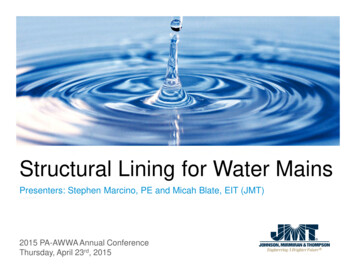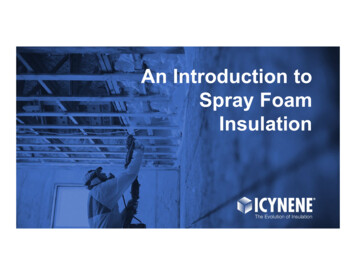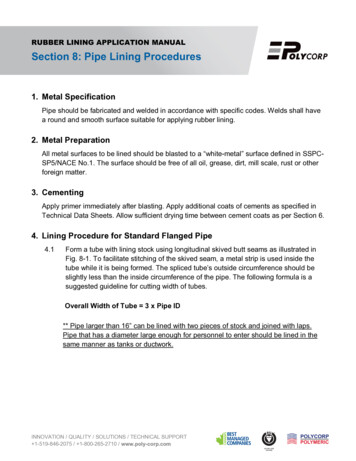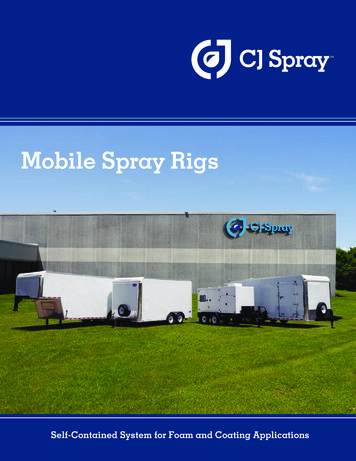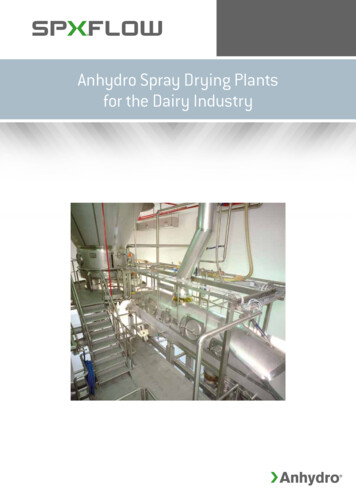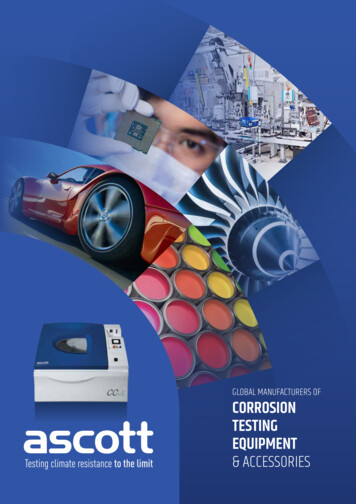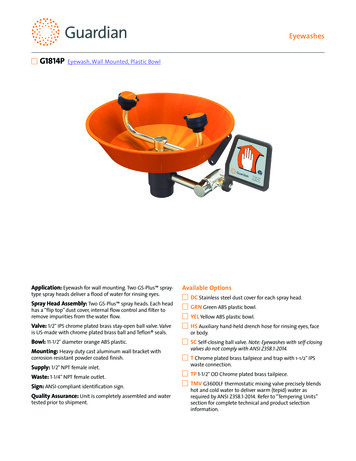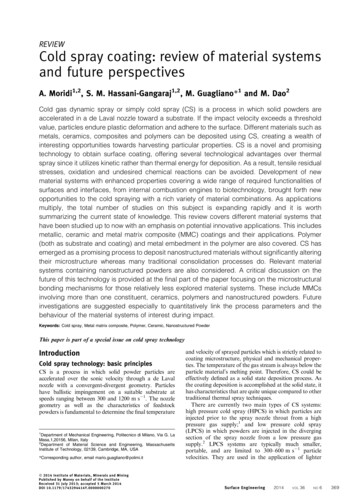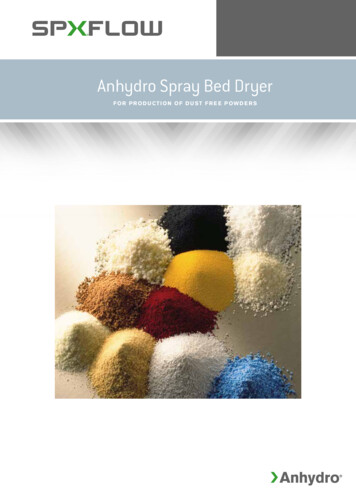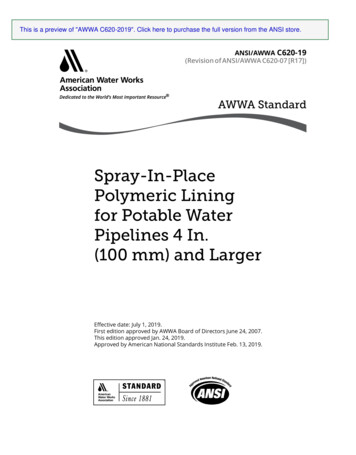
Transcription
This is a preview of "AWWA C620-2019". Click here to purchase the full version from the ANSI store.ANSI/AWWA C620-19(Revision of ANSI/AWWA C620-07 [R17]) AWWA StandardSpray-In-PlacePolymeric Liningfor Potable WaterPipelines 4 In.(100 mm) and LargerEffective date: July 1, 2019.First edition approved by AWWA Board of Directors June 24, 2007.This edition approved Jan. 24, 2019.Approved by American National Standards Institute Feb. 13, 2019.SM
This is a preview of "AWWA C620-2019". Click here to purchase the full version from the ANSI store.AWWA StandardThis document is an American Water Works Association (AWWA) standard. It is not a specification. AWWA standards describeminimum requirements and do not contain all of the engineering and administrative information normally contained inspecifications. The AWWA standards usually contain options that must be evaluated by the user of the standard. Until eachoptional feature is specified by the user, the product or service is not fully defined. AWWA publication of a standard doesnot constitute endorsement of any product or product type, nor does AWWA test, certify, or approve any product. Theuse of AWWA standards is entirely voluntary. This standard does not supersede or take precedence over or displace anyapplicable law, regulation, or code of any governmental authority. AWWA standards are intended to represent a consensusof the water industry that the product described will provide satisfactory service. When AWWA revises or withdraws thisstandard, an official notice of action will be placed in the Official Notice section of Journal AWWA. The action becomeseffective on the first day of the month following the month of Journal AWWA publication of the official notice.American National StandardAn American National Standard implies a consensus of those substantially concerned with its scope and provisions. AnAmerican National Standard is intended as a guide to aid the manufacturer, the consumer, and the general public. Theexistence of an American National Standard does not in any respect preclude anyone, whether that person has approvedthe standard or not, from manufacturing, marketing, purchasing, or using products, processes, or procedures notconforming to the standard. American National Standards are subject to periodic review, and users are cautioned to obtainthe latest editions. Producers of goods made in conformity with an American National Standard are encouraged to stateon their own responsibility in advertising and promotional materials or on tags or labels that the goods are produced inconformity with particular American National Standards.Caution Notice: The American National Standards Institute (ANSI) approval date on the front cover of this standard indicatescompletion of the ANSI approval process. This American National Standard may be revised or withdrawn at any time. ANSIprocedures require that action be taken to reaffirm, revise, or withdraw this standard no later than five years from the dateof ANSI approval. Purchasers of American National Standards may receive current information on all standards by callingor writing the American National Standards Institute, 25 West 43rd Street, Fourth Floor, New York, NY 10036; 212.642.4900,or e-mailing info@ansi.org.All rights reserved. No part of this publication may bereproduced or transmitted in any form or by any means,electronic or mechanical, including scanning, recording, or anyinformation or retrieval system. Reproduction and commercialuse of this material is prohibited, except with written permissionfrom the publisher. Please send any requests or questions topermissions@awwa.org.ISBN-13, print:978-1-62576-348-8eISBN-13, electronic:978-1-61300-518-7DOI: http://dx.doi.org/10.12999/AWWA.C620.19All rights reserved. No part of this publication may be reproduced or transmitted in any form or by any means,electronic or mechanical, including scanning, recording, or any information or retrieval system. Reproduction andcommercial use of this material is prohibited, except with written permission from the publisher.Copyright 2019 by American Water Works AssociationPrinted in USAii
This is a preview of "AWWA C620-2019". Click here to purchase the full version from the ANSI store.Committee PersonnelThe AWWA Subcommittee for Applied Linings, responsible for the revision of C620, had thefollowing personnel at the time of revision:Randall Cooper, ChairL.J. Assard, Michels Corp., Watertown, Conn.J. Baglier, Macomb, Mich.G.J. Bontus, AEGION Corp., Edmonton, Alta.R. Cooper, Evanco Environmental Technologies, Bracebridge, Ont.D.P. Ebner, Michels Corp., Watertown, Conn.M. Fox, Hydratech LLC, Cincinnati, OhioJ.E. Hohider, Michels Corp., Watertown, Conn.D.M. Hughes, American Water, Medford, N.J.S. Joseph, Acuro, Inc., Hudson, Que.C. Macey, AECOM, Winnipeg, Man.R.A. Martin, NSF International, Ann Arbor, Mich.J.C. Matthews, Trenchless Technology Center, Ruston, La.M. Najafi, UTA/CUIRE, Arlington, Tex.B.A. Neu, Mott MacDonald, Jacksonville, Fla.P.G. Oram, AECOM, Norfolk, Va.W.E. Shook, PERMAFORM, Johnston, IowaT.R. Volz, AECOM, Denver, Colo.The AWWA Standards Committee on Pipe Rehabilitation, which reviewed and approved thisstandard, had the following personnel at the time of approval:Dr. Mohammad Najafi, ChairGeneral Interest MembersA. Alavinasab, Pure Engineering Services Inc., Brachburg, N.J.S. Barraco, Carollo Engineers, Dallas, Tex.R. Cooper, Evanco Envrionmental Technologies, Bracebridge, Ont.W. Dixon,* Dixon Engineering, Lake Odessa, Mich.D. Ellison, HDR, Inc., Ventura, Calif.* Liaison, nonvotingiii
This is a preview of "AWWA C620-2019". Click here to purchase the full version from the ANSI store.A. Fuller,* AECOM, Baltimore, Md.P. Glus, Malcolm Pirnie, Inc., Long Island City, N.Y.J. Glynn, Woodard & Curran, Walnut Creek, Calif.J. Loiacono, St. Leonard, Que.C. Macey, AECOM, Winnipeg, Man.J.C. Matthews, Trenchless Technology Center, Ruston, La.E. Meek,† Standards Engineer Liaison, AWWA, Denver, Colo.M. Najafi, UTA/CUIRE, Arlington, Tex.B.A. Neu, Mott MacDonald, Jacksonville, Fla.L.E. Osborn, Dardenne Prairie, Mo.P. Salvo,* Game Consultants, Montreal, Que.J. Turner, Phoenix Civil Engineering, Inc., Ventura, Calif.T.R. Volz, AECOM, Denver, Colo.J.S. Wailes, Black Hawk, Colo.Producer MembersL.J. Assard, Michels Corp., Watertown, Conn.J. Barsoom,* SIPP Technologies LLC, Westminster, Colo.G.J. Bontus, AEGION Corp., Edmonton, Alta.D. Cohen, Breckenridge, Colo.P. Creelman, Royal Building Products, Langley, B.C.M. Davison, Sanexen Water Inc., Brossard, Que.A. Jachim, Saint Paul, Minn.D. Kozman, Hammerhead Trenchless Equipment, Hillard, OhioK.B. Oxner, Inliner Technologies LLC, Paoli, Ind.F. Sever, Quake Wrap Inc., Tucson, Ariz.W.E. Shook, PERMAFORM, Johnson, IowaR.D. Tatum,* AEGION, Sarasota, Fla.K. Weisenberg, SIPP Technologies LLC, Jacksonville, Fla.* Alternate†Liaison, nonvotingiv
This is a preview of "AWWA C620-2019". Click here to purchase the full version from the ANSI store.User MembersW.A. Fritz, Great Lakes Water Authority, Detroit, Mich.M.E. Grahek, Los Angeles Department of Water, Los Angeles, Calif.T.M. Kennedy, Rainbow Municipal Water District, Fallbrook, Calif.D.F. Lesnieski, Connecticut Water Co., East Windsor, Conn.R. McKaskle, City of Tulsa, Tulsa, Okla.C. Venkatesh, American Water, Voorhees, N.J.T.L. White, City of Vista, Vista, Calif.v
This is a preview of "AWWA C620-2019". Click here to purchase the full version from the ANSI store.This page intentionally blank.
This is a preview of "AWWA C620-2019". Click here to purchase the full version from the ANSI store.ContentsAll AWWA standards follow the general format indicated subsequently. Some variations from thisformat may be found in a particular standard.SEC.PAGESEC.ForewordIIntroduction. ixI.ABackground. ixI.BHistory. ixI.CAcceptance.IISpecial Issues. 2Polymeric Lining Materials.34.3Structural Classification of LiningTechniques.57II.A Chlorine and ChloramineDegradation of Elastomers. xi4.4General Pre-Lining Considerations.II.B Handling Precautions. xii4.5Procedures for Polymeric Lining ofWater Mains. 10II.D Purchaser’s Role. xii4.6Permeation. 18III5Verification5.1Quality Assurance and ControlRecords. 195.2Basis for Rejection. 196Delivery6.1Affidavit of Compliance. 19II.C Constructor Experience. xiiUse of This Standard. xiiIII.A Purchaser Options and Alternatives. xiiIII.B Modification to Standard. xivIVMajor Revisions. xivVComments. tion.22References.2AppendixesviiAProviding A Temporary WaterSupply System. 21BSpray-In-Place Polymeric (SIPP)Lining Faults. 25
This is a preview of "AWWA C620-2019". Click here to purchase the full version from the ANSI store.SEC.PAGESEC.PAGEFiguresB.5Collapsed Spray Liner. 27B.1a Pipe Before Cleaning andB.6Spray Lining that has Disbondedfrom the Host Pipe. 28B.7Spray Liner with Slump at the PipeCrown. 29B.8Spray Liner with Ringing. 29B.9Spray Liner with Ringing andInadequate Service Coverage(Spray Shadow). 30Preparation. 25B.1b Cleaned, Prepared, andDried Pipe. 25B.2Properly Executed Spray-LinedPipe. 26B.3Spray-Lined Pipe with Blisters. 26B.4Spray-Lined Pipe with Ringing andB.10 Spray-Lined Pipe with InadequateCoverage at the Pipe Joint. 31Invert Slump. 27viii
This is a preview of "AWWA C620-2019". Click here to purchase the full version from the ANSI store.ForewordThis foreword is for information only and is not a part of ANSI*/AWWA C620.I.Introduction.I.A.Background. Water pipe rehabilitation through application of polymerbased in situ spray lining has been used to provide a relatively impervious barrier betweenthe water transported in the pipe and the inside pipe wall to prevent its corrosion andtuberculation. It has been recognized for over 40 years as a viable means of renewingwater pipe infrastructure. The advantages of trenchless technology construction arerealized, with the added benefits of a small construction site footprint and the potentialfor rapid return to service.I.B.History. The original pipe rehabilitation method of in situ spray liningused cement mortar, and this remains a standard practice in North America. Cementcure time is generally a minimum of 24 h before water can be introduced back into themain. Thus, a temporary water supply system is needed.A second in situ polymeric lining method developed in the United Kingdom (UK)in the 1970s utilizes a two-component epoxy resin liner system that is pumped underpressure through a spray head. The two reactive components are pumped separatelywithin the single umbilical hose and are only mixed together at the spray head, justbefore application to the pipe wall. Spray epoxy linings continue to be used and protectthe host pipe by providing a barrier between the water and the original pipe interior.These polymeric linings cure more rapidly than cement mortar, improve the C factorof the pipe, are durable, and are also resilient to soft and aggressive waters.Newer polymeric materials are being developed for use in the UK and NorthAmerica, providing faster cure times and a wider range of performance properties. Thesematerials include polyureas, polyurethanes or some combination of both (hybrids).These two-component, thermosetting, corrosion-resistant, solvent-free polymericsare rapid-setting and can be applied in multiple lifts to provide a semistructural piperehabilitation. Pipeline holes and gaps can be spanned depending upon the mechanicalproperties of the polymeric material as well as the size of the hole or gap. A wide varietyof formulations are available, each with their own unique set of properties includingenhanced moduli, better water tolerance, shorter cure times, or increased ductility.Many of these polymeric formulations are also certified to NSF/ANSI Standard 61,can meet the requirements of AWWA Class I, II, and III semistructural classifications* American National Standards Institute, 25 West 43rd Street, Fourth Floor, New York, NY 10036.ix
This is a preview of "AWWA C620-2019". Click here to purchase the full version from the ANSI store.for linings, and may facilitate rapid return to service for water utilities, subject toregulatory agency requirements.This lining technology using polymeric materials is frequently referred to asspray-in-place polymeric lining, or SIPP. This acronym covers a broad range ofmaterials, and users should acquaint themselves with the performance properties,application, and limitations of each material to assess fitness for a specificuse/applicationThe first edition of AWWA Standard C620, Spray-Applied In-Place Epoxy Lining ofWater Pipelines, 3 In. (75 mm) and Larger, described the requirements for the materialsand application of an epoxy lining to the inside surface of previously installed waterpipelines 3 in. (75 mm) in diameter and larger. The water pipelines to be rehabilitatedmay be constructed of any of the following materials: steel, ductile iron, cast iron,asbestos, cement, and concrete.The first edition of this standard was approved by the AWWA Board of Directorson June 24, 2007, and it was reaffirmed without revision on June 11, 2017. Thisedition was approved on Jan. 24, 2019.I.C. Acceptance. In May 1985, the US Environmental Protection Agency(USEPA) entered into a cooperative agreement with a consortium led by NSFInternational (NSF) to develop voluntary third-party consensus standards and acertification program for direct and indirect drinking water additives. Other members ofthe original consortium included the Water Research Foundation (formerly AwwaRF)and the Conference of State Health and Environmental Managers (COSHEM). TheAmerican Water Works Association (AWWA) and the Association of State DrinkingWater Administrators (ASDWA) joined later.In the United States, authority to regulate products for use in, or in contact with,drinking water rests with individual states*. Local agencies may choose to imposerequirements more stringent than those required by the state. To evaluate the healtheffects of products and drinking water additives from such products, state and localagencies may use various references including1. Specific policies of the state or local agency.2. Two standards developed under the direction of NSF†, NSF/ANSI 60,Drinking Water Treatment Chemicals—Health Effects, and NSF/ANSI 61, DrinkingWater System Components—Health Effects.* Persons outside the United States should contact the appropriate authority having jurisdiction.†NSF International, 789 North Dixboro Road, Ann Arbor, MI 48105.x
This is a preview of "AWWA C620-2019". Click here to purchase the full version from the ANSI store.3. Other references, including AWWA standards, Food Chemicals Codex, WaterChemicals Codex*, and other standards considered appropriate by the state or localagency.Various certification organizations may be involved in certifying products inaccordance with NSF/ANSI 61. Individual states or local agencies have authority toaccept or accredit certification organizations within their jurisdiction. Accreditation ofcertification organizations may vary from jurisdiction to jurisdiction.Annex A, “Toxicology Review and Evaluation Procedures,” to NSF/ANSI 61 doesnot stipulate a maximum allowable level (MAL) of a contaminant for substances notregulated by a USEPA final maximum contaminant level (MCL). The MALs of anunspecified list of “unregulated contaminants” are based on toxicity testing guidelines(noncarcinogens) and risk characterization methodology (carcinogens). Use of AnnexA procedures may not always be identical, depending on the certifier.ANSI/AWWA C620 does not address additives requirements. Thus, users of thisstandard should consult the appropriate or local agency having jurisdiction in order to1. Determine additives requirements, including applicable standards.2. Determine the status of certifications by parties offering to certify productsfor contact with, or treatment of, drinking water.3. Determine current information on product certification.II. Special Issues.II.A. Chlorine and Chloramine Degradation of Elastomers. The selectionof materials is critical for water service and distribution piping in locations wherethere is a possibility that elastomers will be in contact with chlorine or chloramines.Documented research has shown that elastomers such as gaskets, seals, valve seats,flexible couplings, thread sealing compounds, and encapsulations may be degradedwhen exposed to chlorine or chloramines. The impact of degradation is a functionof the type of elastomeric material, chemical concentration, contact surface area,elastomer cross section, environmental conditions, and temperature. Careful selectionof and specifications for elastomeric materials and the specifics of their application foreach water system component should be considered to provide long-term usefulnessand minimum degradation (swelling, loss of elasticity or softening) of the elastomerspecified.* Both publications available from National Academy of Sciences, 500 Fifth Street, NW, Washington,DC 20001.xi
This is a preview of "AWWA C620-2019". Click here to purchase the full version from the ANSI store.II.B. Handling Precautions. Unmixed or uncured resin and activators mayrepresent a chemical hazard. The mixing of the resin base and activator should onlybe permitted under controlled conditions. Personnel are advised to use caution, followmaterial supplier and manufacturer’s written instructions, and to wear protectiveclothing and proper PPE (i.e., gloves, protective suit, goggles, and suitable respirator)when handling these materials. For proper safety usage, refer to the applicable safetydata sheets (SDS) available from the material supplier or manufacturer.II.C. Constructor Experience. The constructor shall have current training andcertification from both the product supplier and the lining application equipmentprovider that the constructor is experienced in the successful application of the requiredspray-in-place polymeric lining. Supervisory personnel must be competent to ensurethat the pipe is suitably cleaned and prepared and that the polymeric components arestored, mixed, and applied within the manufacturer’s requirements and in accordancewith the manufacturer’s quality control requirements.II.D. Purchaser’s Role. It is important in the application of spray-in-placepolymers that the purchaser or its field representative ensures the constructor’sadherence to the quality assurance plan and highlights any variations or omissionswhich could compromise the installation.III. Use of This Standard. It is the responsibility of the user of an AWWAStandard to determine that the products described in that standard are suitable for usein the particular application being considered.III.A. Purchaser Options and Alternatives. The following information shall beprovided by the purchaser:1. Standard used—that is, ANSI/AWWA C620, Spray-in-Place PolymericLining for Potable Water Pipelines 4 In. (100 mm) and Larger, of latest revision.2. Whether compliance with NSF/ANSI 61, Drinking Water SystemComponents—Health Effects, is required, in addition to requirements of the SafeDrinking Water Act.3. Temporary water supply requirements.4. Diameter, material, length, age, existing interior lining, maintenance andrepair history, and location of pipeline, including plan and profile drawings whenavailable; limits of pipeline shutdowns, if service requirements make limits necessary;location, type, and size of valves; location of interconnecting pipelines, hydrant branches,and service pipes/lines; location of fittings and restrictions that could interfere withcleaning and lining operations; location, diameter, and connections of temporary waterxii
This is a preview of "AWWA C620-2019". Click here to purchase the full version from the ANSI store.supply, if required; chemical characteristics of the water conveyed and other details ofthe pipe within the scope of the contract between the purchaser and the contractor.5. Requirements for the polymeric lining properties and thickness. Nominaldry film thickness (DFT) of polymeric lining required—generally 40 mil (1 mm) andminimum cure time of the liner between its application and reintroduction of waterinto the pipe.6. Services furnished by purchaser. Description of services or field operationsto be performed by the purchaser, such as locating the main to be cleaned and lined,removal and replacement of line valves, operation of valves, tagging valves that separatethe main to be cleaned and lined from the water system to prevent accidental opening,shutting off inflow of water from connecting pipelines, locating and operating blowoffs, connecting and disconnecting temporary water supply to customer services,obtaining permits required for the work, handling customer contacts, disinfection,bacterial acceptance testing, and conducting pressure and flow tests.7. Additional work to be performed by constructor. Description of work,including repairs to deteriorated pipe, excavation, backfill, and restoration work ataccess excavations; method of opening and closing access openings in the pipeline;flushing, laying, and removing temporary water supply piping; and operation of mainline or blow-off valves.NOTE: When it is necessary to repair deteriorated pipe before lining, the pipe willbe repaired by the purchaser or under provisions of the contract between the purchaserand the constructor.8. Supply of water for cleaning and lining operations: Location of water sources,method of providing, flow quantity available, metering requirements, cross-connectionprotection requirements and pressure information.9. Disposal of cleaning water and debris. Requirements for the disposal ofcleaning water, old lining, and other debris; instructions regarding permits from theresponsible authorities.10. Other purchaser options. Further options that may be specified by thepurchaser:a. Affidavit of compliance.b. Access openings and surface restoration.c. Traffic control.d. Cleaning of valves, installing new bolts and gaskets.e. Disinfection of temporary water supply system.xiii
This is a preview of "AWWA C620-2019". Click here to purchase the full version from the ANSI store.f. Replacing/repairing faulty/leaking valves.g. Cathodic protection.h. Service line and/or meter box repairs.i. Meter upgrades.j. Hydrant and isolation valve replacement.11. Rejection of work. The purchaser should specify a procedure for reportingthe rejection of work not performed in accordance with this standard. The purchasershould also outline the responsibility of the purchaser and the constructor in cases ofnonstandard work.12. Warranty period. The purchaser should specify the duration of the warrantyperiod and warranty inspection protocols and outline the responsibility of the purchaserand the constructor in cases of nonconforming work discovered during the warrantyperiod.13. Option for further investigation. The purchaser may wish to make furtherinvestigation of any pipe where the structural condition of the pipeline is questionablebefore lining.14. Supply of color chart. To facilitate inspection before and during mixing, thetwo components may be supplied in two distinct colors that, when mixed together inthe proper ratio, shall produce a third distinct color. Whenever requested, the linermanufacturer shall provide to the purchaser its color chart for each unmixed and mixedcomponent.15. Field quality control requirements. Additional field quality controlrequirements including inspections, evaluations, sampling, and testing may be imposedat the purchaser’s discretion. For example, dry thickness measurement may be takenwith random sampling by extracting spool pieces or coupons of pipe after curing.III.B. Modification to Standard. Any modification to the provisions, definitions,or terminology in this standard must be provided by the purchaser.IV. Major Revisions. Major revisions made to the standard in this editioninclude the following:1. The title of the standard was changed from “Spray-Applied In-Place EpoxyLining of Water Pipelines, 3 In. (75 mm) and Larger” to “Spray-In-Place PolymericLining for Potable Water Pipelines 4 In. (100 mm) and Larger.”2. The standard has been extensively revised and amended to include therequirements and procedures for spray-in-place lining of potable water pipes usingpolymeric materials, including epoxies, polyurethanes, polyureas, and polymerichybrids.xiv
This is a preview of "AWWA C620-2019". Click here to purchase the full version from the ANSI store.V.Comments. If you have any comments or questions about this standard,please call AWWA Engineering and Technical Services at 303.794.7711, FAX at303.795.7603, write to the department at 6666 West Quincy Avenue, Denver, CO80235-3098, or e-mail at standards@awwa.org.xv
This is a preview of "AWWA C620-2019". Click here to purchase the full version from the ANSI store.This page intentionally blank.
This is a preview of "AWWA C620-2019". Click here to purchase the full version from the ANSI store.ANSI/AWWA C620-19(Revision of ANSI/AWWA C620-07 [R17]) AWWA StandardSpray-In-Place Polymeric Lining forPotable Water Pipelines 4 In.(100 mm) and LargerSECTION 1:Sec. 1.1GENERALScopeThis standard describes the requirements for materials, equipment,certification, and procedures for the field application of spray-in-place polymeric(SIPP) linings to the interior of existing potable water pipelines. The water pipelinesto be renewed may be constructed of pipe materials such as steel, ductile iron,cast iron, asbestos cement, and concrete. Related work required for performing acomplete contract is also generally described.The standard covers all polymeric materials used in spray-in-place applicationsincluding epoxies, polyurethanes, polyureas, and hybrids of these compounds.The in-situ spray application of polymeric linings is appropriate for pipesections that can be lined with a computerized spray rig. The umbilical hose ofthe rig is inserted through the pipeline and then withdrawn progressively anduniformly using a computerized winch and spray head that applies the lining onthe pipe surface to provide a continuous, smooth lining of uniform thickness.1
cure time is generally a minimum of 24 h before water can be introduced back into the main. Thus, a temporary water supply system is needed. A second in situ polymeric lining method developed in the United Kingdom (UK) in the 1970s utilizes a two-component epoxy resin liner system that is pumped under pressure through a spray head.
